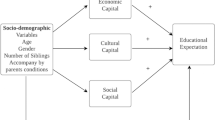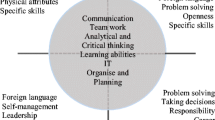Abstract
Skills development remains on the international development agenda but fails to get adequate attention. Based on prolonged fieldwork with a particularly marginalised community of children and young adults in the northern Nigerian state of Kano, this article shows how in contexts of extreme poverty the demand for skills training can supersede that for basic education. Further, by drawing on results of a six-month-long skill-training intervention, the article documents the scope for increased experimentation in the delivery of low-cost community-based skill-training programmes and identifies factors that influence programme completion. It also demonstrates that participation in skill-training programmes can dramatically increase entrepreneurial aspirations among marginalised youth, but that without access to credit most fail to pursue their aspirations. Below certain poverty thresholds, the dire resource constraints make change in aspirations an unreliable predictor of possible improvement in future outcomes.
Le développement des compétences reste à l’ordre du jour du développement international, mais ne parvient pas à obtenir une attention adéquate. Basé sur des travaux de terrain prolongés avec une communauté particulièrement marginalisée d’enfants et de jeunes adultes dans l’état de Kano au nord du Nigéria, cet article montre comment, dans les contextes d’extrême pauvreté, la demande en formation professionnelle peut supplanter celle pour l’éducation de base. En outre, en s’appuyant sur les résultats d’une intervention de formation professionnelle d’une durée de six mois, l’article documente la possibilité d’une expérimentation accrue dans la mise en œuvre de programmes de formation professionnelle à base communautaire et à faibles coûts, et identifie les facteurs qui influent sur l’achèvement du programme. Il démontre également que la participation à des programmes de formation professionnelle peut considérablement accroître les aspirations entrepreneuriales des jeunes marginalisés, mais que sans l’accès au crédit, la plupart ne parviennent pas à poursuivre leurs aspirations. En deçà de certains seuils de pauvreté, les terribles contraintes de ressources font du changement dans les aspirations un prédicteur peu fiable de l’amélioration éventuelle des résultats futurs.

Source: Own survey data.


Similar content being viewed by others
References
Admassie, A. (2003) Child labour and schooling in the context of a subsistence rural economy: Can they be compatible?. International Journal of Educational Development 23: 167–185.
Allais, S. (2012a) “Economic Imperialism”, education policy and educational theory. Journal of Education Policy 27(2): 253–274.
Allais, S. (2012b) Will skills save us? Rethinking the relationships between vocational education, skills development policies, and social policy in South Africa. International Journal of Educational Development 32(5): 632–642.
Amin, S., Ahmed, J., Saha, J. and Haque, E.F. (2016) Delaying Child Marriage through Community-Based Skill-Development Programs for Girls. Dhaka: Population Council.
Antoninis, M. (2014) Tackling the largest global education challenge? Secular and religious education in northern Nigeria. World Development 59: 82–92.
Appadurai, A. (2001) The capacity to aspire: Culture and the terms of recognition. In: Vijayendra Rao and M. Walton (eds.), Culture and Public Action. Stanford: Stanford University Press.
Bandura, A. (1977) Social Learning Theory. Englewood Cliffs: General Learning Press.
Bano, M. (2008) Engaged Yet Disengaged: Islamic Schools and the State in Kano, Nigeria, Religions and Development Research Programme Working Paper 29. Birmingham: University of Birmingham.
Bernard, T., Dercon, S., Orkin, K. and Taffesse, S. (2014) The Future in Mind: Aspirations and Forward-looking Behaviour in Rural Ethiopia. CSAE Working Paper, WPS/2014-2016.
Billetoft, J. (2014) Education and Skills Post-2015 and the Global Governance of Education: Agendas and Architecture. Network for International Policies and Cooperation in Education and Training, http://www.norrag.org/de/publications/norrag-news/online-version/education-and-skills-post-2015-and-the-global-governance-of-education-agendas-and-architecture/detail/skills-and-employment-the-dfid-way.html, accessed 11 July 2017.
Brigaglia, A. (2008) “We Ain’t Coming To Take People Away”: A Sufi praise-song and the representation of police forces in northern Nigeria. Annual Review of Islam in Africa 10(2008–2009): 50–57.
Conradie, I. (2013) Can deliberate efforts to realise aspirations increase capabilities? A South African case study. Oxford Development Studies 41(2): 189–219.
Conradie, I. and Robeyns, I. (2013) Aspirations and human development interventions. Journal of Human Development and Capabilities 14(4): 559–580.
CUBE (2008) Islamiyya, Quranic, and Tsangaya Education in Kano. Kano: CUBE.
ESSPIN (2010) Integrating the Old with the New. Islamic Education Responds to the Demands of Modern Society, Kano: Education Sector Support Programme in Nigeria.
ESSPIN (2015) Lessons from Tsangaya School Integration Model. Kano: Education Sector Support Programme in Nigeria.
European Commission (2012) TVET and Skills Development in EU Development Cooperation. Final Report No. 308055/1, http://ec.europa.eu/europeaid/sites/devco/files/tvet-study-aets-2012-final-report_en.pdf.
GMR and USI (2014) Progress in Getting All Children to School Stalls but Some Countries Show the Way Forward. Policy Paper 14, http://www.uis.unesco.org/Education/Documents/fs-28-out-of-school-children-en.pdf.
Hoechner, H. (2011) Striving for knowledge and dignity: How Quranic students in Kano, Nigeria, learn to live with rejection and educational disadvantage. European Journal of Development Research 23(5): 712–728.
Hoechner, H. (2014) Traditional Qur’anic students (almajirai) in Nigeria: Fair game for unfair accusations? In: M.-A. Pérouse de Montclos (ed.) Boko Haram: Islamism, Politics, Security and the State in Nigeria. Leiden: African Studies Centre.
Ibrahim, S. (2011) Poverty, Aspirations and Wellbeing: Afraid to Aspire and Unable to Reach a Better Life – Voices from Egypt. BWPI Working Paper 141, University of Manchester.
ILO (2011) Skills Development through Community-based Rehabilitation (CBR): A Good Practice Guide. Switzerland: ILO, http://www.ilo.org/wcmsp5/groups/public/@ed_emp/documents/publication/wcms_159136.pdf.
Jeffrey, C. (2010) Timepass: Youth, Class, and the Politics of Waiting in India. Stanford: Stanford University Press.
KERD (2014) Official Primary Transition Exam Results. Kano: Ministry of Education.
King, K. and Palmer, R. (2007) Skills Development and Poverty Education: A State of the Art Review. NA: European Training Foundation.
Locke, E. and Latham, G. (2002) Building a practically useful theory of goal setting and task motivation: A 35 year odyssey. American Psychologist 57(9): 705–717.
McGrath, S. (2010) Beyond aid effectiveness: The development of the South African further and training college sector, 1994–2009. International Journal of Educational Development 30(5): 525–534.
McGrath, S. (2012) Vocational education and training for development: A policy in need of a theory? International Journal of Educational Development 32: 623–631.
Ministry of Education (MoE), Kano State (2008) Education Strategy Plan:2009–2018. Kano State: Federal Republic of Nigeria.
Ministry of Education (MoE) (2010) Kano State Annual Education Sector Report 2010. Kano State: Federal Republic of Nigeria.
OECD (2012) Better Skills, Better Jobs, Better Lives – A Strategic Approach to Skills Policies. NA: OECD Publishing.
Palmer, R. (2014) ‘Technical and vocational skills and post-2015: Avoiding another vague skills goal? International Journal of Educational Development 39: 32–39.
Powell, L. (2012) Reimagining the purpose of VET – expanding the capability to aspire in South African future education and training students. International Journal of Educational Development 32: 643–653.
Ray, D. (2003) Aspirations, poverty and economic change. Paper presented at World Bank conference on Culture and Development, Washington DC.
Rose, P. (2013) Are We on Track for a Global Education Goal? Reflections on Global Meeting on Education Post-2015. World Education Blog, www.efare-port.wordppress.com, accessed 14 July 2017.
Serneels, P. and Dercon, S. (2014) Aspirations, Poverty and Education: Evidence from India, Young Lives Working Paper 125. Oxford: Oxford University.
UNESCO (2012) EFA Global Monitoring Report 2012. Youth and Skills: Putting Education to Work. Paris: UNESCO.
UNICEF (2014) Community-based Schools Bring Hope to Afghanistan’s Remote Settlements, http://www.unicef.org/infobycountry/afghanistan_38434.html, accessed 14 July 2017.
UNICEF (2015) Nigeria Country Profile, http://www.unicef.org/nigeria/children_1941.html, accessed 14 July 2017.
USAID (2012) Meeting EFA: Afghanistan Community Schools, http://pdf.usaid.gov/pdf_docs/PNADI076.pdf, accessed 14 July 2017.
Acknowledgements
I will like to thank Andy Hinsley from DFID for approving this non-formal skills training intervention and Jake Ross and Ron Tuck from Cambridge Education for overseeing its implementation. Continued discussions with all three greatly helped refine the analysis.
Author information
Authors and Affiliations
Corresponding author
Technical Annex
Technical Annex
Variables Influencing the Probability of Training Completion
Using the survey implemented with the youth who took part in the programme, an attempt was made to test particular variables highlighted in the survey (age, trainer quality, type of education, income, etc.) that could potentially affect the probability of a child completing the training programme. The following set of analyses attempt to identify the reasons why youth in the treatment group who received training may have failed to complete the programme. Using ‘completion of the training programme’ as the binary outcome variable, this analysis compares results from probit, logit, and LPM models. Findings do not differ greatly between models. The following tables display all three models.
Section 1: Factors affecting completion of training
Table 5 displays the results using the four variables of primary interest (Schools: Government Primary, Islamiyya, Tsangaya, and ESSPIN) as well as a number of controls which would probably have an impact on whether a child completes the training programme or not. The rationale behind these controls is presented below.
Age and age2 Age could potentially have an impact on whether students complete the training or not. Younger students may be more determined than older students to learn new skills. However, age often does not share a linear relationship with most dependent variables, which is why we include age2 (the square of the age variable). In our regression model above, it is demonstrated that age shares a significant bell curve relationship with completion rate, i.e. students are more likely to complete the training programme as age increases up to a certain cut-off age, after which point they are more likely to drop out.
Education level Students with different levels of education may have different motivations for completing the training.
Family income level It is possible that as family income increases, so should completion rate.
Enough to eat Whether a child gets enough to eat or not is a reflection not only on income but also health.
Trainer quality Higher trainer quality increases the likelihood of completing the programme. This result is also significant.
Stop work for training This may alter the cost of continuing education.
The 1st, 3rd, and 5th columns show the coefficient or parameter estimates of each of the models and are interpreted as ‘the estimated effect of age on completion is 0.25 in the probit model’, which is often a less clear way of showing the impact. The 2nd, 4th, and 6th columns display the marginal effects. The interpretation of these values is the average predicted difference in the probability of completing the training between individuals born one year apart. Therefore, the average difference in probability of completing the training programme is 6 per cent for each year. As can be seen, the different models do not vary greatly in values, signs, or significance.
Section 2: Trainer's attributes affecting completion of training
Trainer Quality
In addition to the above analysis, it was also deemed fit to investigate if the quality of training, based on a number of characteristics, influence whether the almajiri students complete training courses. The survey had included a number of questions that highlight different characteristics that influence the quality of training. Table 5 notes trainer quality to have a significant impact on completion. This section therefore identifies the particular aspects of trainer quality that may have an impact on this relationship.
Where:
Questionnaire | |
|---|---|
trainer_bad_workshop | Had a bad workshop |
trainer_encouraging | Was encouraging |
trainer_good_workshop | Had a good workshop |
trainer_knew_skills | Knew the skill techniques |
trainer_regular | Regular in holding the class |
trainer_scolded | Scolded a lot |
trainer_shared_skills | Shared the skills fully |
trainer_walking_dist | Located at a walkable distance |
Note, Table 6 displays only the results of the trainer characteristics. All other variables from Table 5 are included in the models as controls but are not displayed in the table.
Rights and permissions
About this article
Cite this article
Bano, M. Skills Development and International Development Agenda Setting: Lessons from an Intervention in Northern Nigeria. Eur J Dev Res 30, 789–808 (2018). https://doi.org/10.1057/s41287-017-0125-0
Published:
Issue Date:
DOI: https://doi.org/10.1057/s41287-017-0125-0




